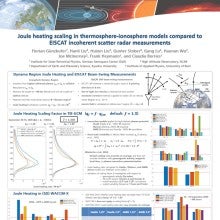Joule heating scaling in thermosphere-ionosphere models compared to EISCAT incoherent scatter radar measurements
Florian
Günzkofer
German Aerospace Center (DLR), Institute for Solar-Terrestrial Physics
Poster
The polar plasma convection originates from the interaction between the interplanetary magnetic field and the Earth’s magnetic field. To model the atmosphere-ionosphere system, the resulting polar electric potential is taken as an upper boundary condition using empirical convection models. These empirical models cannot represent short-term variations of the electric field which has been shown to cause a systematic underestimation of ionospheric Joule heating rates at high latitudes. Commonly, atmosphere-ionosphere models apply a Joule heating scaling factor for compensation. For example, a constant scaling factor of 1.5 is applied in the Thermosphere Ionosphere Electrodynamics General Circulation Model (TIE-GCM).
We evaluate the accuracy of this constant scaling factor by comparing Joule heating rates calculated from the TIE-GCM with those estimated from measurements by the EISCAT incoherent scatter radar in Tromsø, Norway (69.6°N, 19.2°E). We investigate TIE-GCM runs driven with the Heelis, Weimer, and AMIE convection models, as well as WACCM-X model runs in standard and high resolution. We show that the required scaling factor varies significantly with geomagnetic activity, solar wind energy input, magnetic local time, and the applied plasma convection model. The impact of the spatial and temporal model resolution on the Joule heating rates is studied as well.
We evaluate the accuracy of this constant scaling factor by comparing Joule heating rates calculated from the TIE-GCM with those estimated from measurements by the EISCAT incoherent scatter radar in Tromsø, Norway (69.6°N, 19.2°E). We investigate TIE-GCM runs driven with the Heelis, Weimer, and AMIE convection models, as well as WACCM-X model runs in standard and high resolution. We show that the required scaling factor varies significantly with geomagnetic activity, solar wind energy input, magnetic local time, and the applied plasma convection model. The impact of the spatial and temporal model resolution on the Joule heating rates is studied as well.

Poster PDF
Poster category
Ionosphere and Thermosphere Research and Applications
Meeting homepage